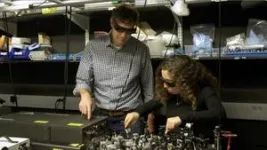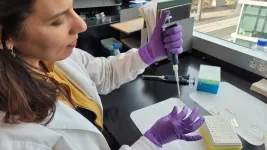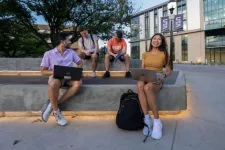(Press-News.org) Physicists have spent more than a century measuring and making sense of the strange ways that photons, electrons, and other subatomic particles interact at extremely small scales. Engineers have spent decades figuring out how to take advantage of these phenomena to create new technologies.
In one such phenomenon, called quantum entanglement, pairs of photons become interconnected in such a way that the state of one photon instantly changes to match the state of its paired photon, no matter how far apart they are.
Nearly 80 years ago, Albert Einstein referred to this phenomenon as "spooky action at a distance." Today, entanglement is the subject of research programs across the world — and it’s becoming a favored way to implement the most fundamental form of quantum information, the qubit.
Currently, the most efficient way to create photon pairs requires sending lightwaves through a crystal large enough to see without a microscope. In a paper published today in Nature Photonics, a team led by Columbia Engineering researchers and collaborators, describe a new method for creating these photon pairs that achieves higher performance on a much smaller device using less energy. P. James Schuck, associate professor of mechanical engineering at Columbia Engineering, helped lead the research team.
These findings represent a significant step forward in the field of nonlinear optics, which is concerned with using technologies to change the properties of light for applications including lasers, telecommunications, and laboratory equipment.
“This work represents the embodiment of the long-sought goal of bridging macroscopic and microscopic nonlinear and quantum optics,” says Schuck, who co-directs Columbia's MS in Quantum Science and Technology. “It provides the foundation for scalable, highly efficient on-chip integrable devices such as tunable microscopic entangled-photon-pair generators.”
Im
How it works
Measuring just 3.4 micrometers thick, the new device points to a future where this important component of many quantum systems can fit onto a silicon chip. This change would enable significant gains in the energy efficiency and overall technical capabilities of quantum devices.
To create the device, the researchers used thin crystals of a so-called van der Waals semiconducting transition metal called molybdenum disulfide. Then they layered six of these crystal pieces into a stack, with each piece rotated 180 degrees relative to the crystal slabs above and below. As light travels through this stack, a phenomenon called quasi-phase-matching manipulates properties of the light, enabling the creation of paired photons.
This paper represents the first time that quasi-phase-matching in any van der Waals material has been used to generate photon pairs at wavelengths that are useful for telecommunications. The technique is significantly more efficient than previous methods and far less prone to error.
“We believe this breakthrough will establish van der Waals materials as the core of next-generation nonlinear and quantum photonic architectures, with them being ideal candidates for enabling all future on-chip technologies and replacing current bulk and periodically poled crystals,” Schuck says.
“These innovations will have an immediate impact in diverse areas including satellite-based distribution and mobile phone quantum communication.”
How it happened
Schuck and his team built on their previous work to develop the new device. In 2022, the group demonstrated that materials like molybdenum disulfide possess useful properties for nonlinear optics — but performance was limited by the tendency of light waves to interfere with one another while traveling through this material.
The team turned to a technique called periodic poling to counteract this problem, which is known as phase matching. By alternating the direction of the slabs in the stack, the device manipulates light in a way that enables photon pair generation at miniscule length scales.
“Once we understood how amazing this material was, we knew we had to pursue the periodic poling, which could allow for the highly efficient generation of photon pairs,” Schuck says.
This work occurred within Programmable Quantum Materials, a Department of Energy energy frontier research center (EFRC) at Columbia, as part of a larger effort to understand and exploit quantum materials. This work was possible due to contributions from the Baso, Delor, and Dean labs. Postdoctoral researcher Chiara Trovatello led the effort.
END
Engineering quantum entanglement at the nanoscale
Researchers have developed a drastically smaller and more energy efficient method of creating coveted photon pairs that influence each other from any distance. The technology could transform computing, telecommunications, and sensing.
2025-01-13
ELSE PRESS RELEASES FROM THIS DATE:
Researchers develop breakthrough one-step flame retardant for cotton textiles
2025-01-13
Although extremely flammable, cotton is one of the most commonly used textiles due to its comfort and breathable nature. However, in a single step, researchers from Texas A&M University can reduce the flammability of cotton using a polyelectrolyte complex coating. The coating can be tailored for various textiles, such as clothing or upholstery, and scaled using the common pad-dry coating process, which is suitable for industrial applications. This technology can help to save property and lives on a large scale.
“Many of the materials in our ...
New study identifies how blood vessel dysfunction can worsen chronic disease
2025-01-13
Researchers at Oregon Health & Science University have uncovered how specialized cells surrounding small blood vessels, known as perivascular cells, contribute to blood vessel dysfunction in chronic diseases such as cancer, diabetes and fibrosis. The findings, published today in Science Advances, could change how these diseases are treated.
The study, led by Luiz Bertassoni, D.D.S., Ph.D., founding director of the Knight Cancer Precision Biofabrication Hub and a professor at the OHSU Knight Cancer Institute and ...
Picking the right doctor? AI could help
2025-01-13
Years ago, as she sat in waiting rooms, Maytal Saar-Tsechansky began to wonder how people chose a good doctor when they had no way of knowing a doctor’s track record on accurate diagnoses. Talking to other patients, she found they sometimes based choices on a physician’s personality or even the quality of their office furniture.
“I realized all these signals people are using are just not the right ones,” says Saar-Tsechansky, professor of information, risk, and operations management at Texas McCombs. “We were operating in complete darkness, like there’s no transparency on these things.”
In new research, she uses artificial ...
Travel distance to nearest lung cancer facility differs by racial and ethnic makeup of communities
2025-01-13
Embargoed for release until 5:00 p.m. ET on Monday 13 January 2025
@Annalsofim
Below please find summaries of new articles that will be published in the next issue of Annals of Internal Medicine. The summaries are not intended to substitute for the full articles as a source of information. This information is under strict embargo and by taking it into possession, media representatives are committing to the terms of the embargo not only on their own behalf, but also on behalf ...
UTA’s student success strategy earns national acclaim
2025-01-13
The University of Texas at Arlington has been recognized nationally for its commitment to student success and economic mobility, being named a winner in the inaugural Postsecondary Success Recognition Program (PSRP), a U.S. Department of Education initiative. This program honors institutions that excel in enrolling underserved student populations, supporting successful student transfers and completions and preparing graduates for careers that promote economic mobility.
UTA was one of only three bachelor’s degree–granting institutions across the nation ...
Wind turbines impair the access of bats to water bodies in agricultural landscapes
2025-01-13
Bats depend on open bodies of water such as small ponds and lakes for foraging and drinking. Access to water is particularly important for survival in the increasingly hot and dry summers caused by climate change, the time when female bats are pregnant and rear their young. A scientific team from the Leibniz Institute for Zoo and Wildlife Research (Leibniz-IZW) has now shown that access to drinking sites is hampered by wind turbines in agricultural landscapes: Many bat species avoid the turbines and water bodies ...
UCF biology researchers win awards from NOAA to support critical coastal work
2025-01-13
Biology researchers in the College of Sciences and UCF Coastal have received two awards from the National Oceanic and Atmospheric Administration (NOAA) totaling more than $2.3 million.
A new $1.1 million award to UCF from NOAA Sea Grant as part of the Marine Debris Challenge Competition will fund joint research between UCF’s CEELAB and Aquatic Biogeochemistry Laboratory’s research on plastic-free restored habitats in coastal shorelines and oyster reefs. UCF’s work, in partnership with Texas A&M, and University of Texas Marine Science Institute was selected as one of 11 projects ...
Geochemist Kevin Rosso appointed a Battelle Fellow
2025-01-13
RICHLAND, Wash.— Geochemist Kevin Rosso, a senior scientific leader at the Department of Energy’s Pacific Northwest National Laboratory, has been named a Battelle Fellow, the highest recognition at PNNL for leadership and accomplishment in science. He joins six other current Battelle Fellows at PNNL in an honor that less than 0.5% of PNNL scientists achieve during their careers.
Rosso is internationally known for his fundamental research on how energy flows among minerals, solutions and microorganisms. These complex processes center on the key role that interfaces—which are shared boundaries—play in controlling ...
NIH-funded study finds cases of ME/CFS increase following SARS-CoV-2
2025-01-13
What: New findings from the National Institutes of Health’s (NIH) Researching COVID to Enhance Recovery (RECOVER) Initiative suggest that infection with SARS-CoV-2, the virus that causes COVID-19, may be associated with an increase in the number of myalgic encephalomyelitis/chronic fatigue syndrome (ME/CFS) cases. According to the results, 4.5% post-COVID-19 participants met ME/CFS diagnostic criteria, compared to 0.6% participants that had not been infected by SARS-CoV-2 virus. RECOVER is NIH’s national program to understand, diagnose, prevent, and treat Long COVID.
The research team, led by Suzanne D. Vernon, Ph.D., from the Bateman Horne Center in Salt Lake City, ...
Biophotovoltaics: A step forward in sustainable energy technology
2025-01-13
In a groundbreaking study published in Environmental Science and Ecotechnology, researchers have advanced our understanding of biophotovoltaic (BPV) systems—innovative devices that merge photosynthetic microbes with electrochemical systems to convert sunlight into electricity. Using the cyanobacterium Synechocystis sp. PCC 6803, the study provides critical insights into the molecular mechanisms driving this green energy technology.
Central to BPV systems is the process of extracellular electron transfer (EET), where electrons generated during photosynthesis are harvested by an electrode via mediators such as ferricyanide. The research reveals that EET ...
LAST 30 PRESS RELEASES:
Making lighter work of calculating fluid and heat flow
Normalizing blood sugar can halve heart attack risk
Lowering blood sugar cuts heart attack risk in people with prediabetes
Study links genetic variants to risk of blinding eye disease in premature infants
Non-opioid ‘pain sponge’ therapy halts cartilage degeneration and relieves chronic pain
AI can pick up cultural values by mimicking how kids learn
China’s ecological redlines offer fast track to 30 x 30 global conservation goal
Invisible indoor threats: emerging household contaminants and their growing risks to human health
Adding antibody treatment to chemo boosts outcomes for children with rare cancer
Germline pathogenic variants among women without a history of breast cancer
Tanning beds triple melanoma risk, potentially causing broad DNA damage
Unique bond identified as key to viral infection speed
Indoor tanning makes youthful skin much older on a genetic level
Mouse model sheds new light on the causes and potential solutions to human GI problems linked to muscular dystrophy
The Journal of Nuclear Medicine ahead-of-print tip sheet: December 12, 2025
Smarter tools for peering into the microscopic world
Applications open for funding to conduct research in the Kinsey Institute archives
Global measure underestimates the severity of food insecurity
Child survivors of critical illness are missing out on timely follow up care
Risk-based vs annual breast cancer screening / the WISDOM randomized clinical trial
University of Toronto launches Electric Vehicle Innovation Ontario to accelerate advanced EV technologies and build Canada’s innovation advantage
Early relapse predicts poor outcomes in aggressive blood cancer
American College of Lifestyle Medicine applauds two CMS models aligned with lifestyle medicine practice and reimbursement
Clinical trial finds cannabis use not a barrier to quitting nicotine vaping
Supplemental nutrition assistance program policies and food insecurity
Switching immune cells to “night mode” could limit damage after a heart attack, study suggests
URI-based Global RIghts Project report spotlights continued troubling trends in worldwide inhumane treatment
Neutrophils are less aggressive at night, explaining why nighttime heart attacks cause less damage than daytime events
Menopausal hormone therapy may not pose breast cancer risk for women with BRCA mutations
Mobile health tool may improve quality of life for adolescent and young adult breast cancer survivors
[Press-News.org] Engineering quantum entanglement at the nanoscaleResearchers have developed a drastically smaller and more energy efficient method of creating coveted photon pairs that influence each other from any distance. The technology could transform computing, telecommunications, and sensing.





